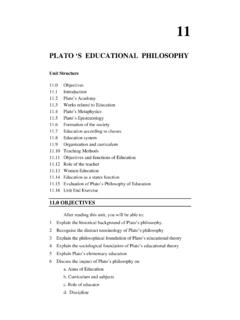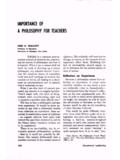Transcription of 2nd edition Encyclopedia of Philosophy - Lambsound
1 2nd editionEncyclopedia ofPhilosophyeophil_fmv2 10/28/05 3:57 PM Page i2nd editionEncyclopedia ofPhilosophy2volumeCABANIS DESTUTT DE TRACYDONALD M. BORCHERTE ditor in Chiefeophil_fmv2 10/28/05 3:57 PM Page iii 2006 Thomson Gale, a part of the , Star Logo and Macmillan Reference USA are trademarks and Gale is a registered trademark used herein under more information, contactMacmillan Reference USAAn imprint of Thomson Gale27500 Drake Hills, MI 48331-3535Or you can visit our internet site at RIGHTS RESERVEDNo part of this work covered by the copyrighthereon may be reproduced or used in anyform or by any means graphic, electronic, ormechanical, including photocopying, record-ing, taping, Web distribution, or informationstorage retrieval systems without the writtenpermission of the permission to use material from thisproduct, submit your request via Web , or youmay download our Permissions Request formand submit your request by fax or mail to:PermissionsThomson Gale 27500 Drake Hills, MI 48331-3535 Permissions Hotline.
2 248-699-8006 or 800-877-4253 ext. 8006 Fax: 248-699-8074 or 800-762-4058 Since this page cannot legibly accommo-date all copyright notices, the acknowledg-ments constitute an extension of thecopyright every effort has been made toensure the reliability of the information presented in this publication, Thomson Galedoes not guarantee the accuracy of the datacontained herein. Thomson Gale accepts nopayment for listing; and inclusion in the publication of any organization, agency, institution, publication, service, or individualdoes not imply endorsement of the editors orpublisher. Errors brought to the attention ofthe publisher and verified to the satisfactionof the publisher will be corrected in of Philosophy , Second EditionDonald M. Borchert, Editor in ChiefLIBRARY OF CONGRESS CATALOGING-IN-PUBLICATION DATAE ncyclopedia of Philosophy / Donald M. Borchert, editor in chief. 2nd bibliographical references and 0-02-865780-2 (set hardcover : alk.)
3 Paper) ISBN 0-02-865781-0 (vol 1) ISBN 0-02-865782-9 (vol 2) ISBN 0-02-865783-7 (vol 3) ISBN 0-02-865784-5 (vol 4) ISBN 0-02-865785-3 (vol 5) ISBN 0-02-865786-1 (vol 6) ISBN 0-02-865787-X (vol 7) ISBN 0-02-865788-8 (vol 8) ISBN 0-02-865789-6 (vol 9) ISBN 0-02-865790-X (vol 10)1. Philosophy Encyclopedias. I. Borchert, Donald M., 2005103 dc222005018573 This title is also available as an e-book. ISBN 0-02-866072-2 Contact your Thomson Gale representative for ordering in the United States of America10 9 8 7 6 5 4 3 2 1eophil_fmv2 10/28/05 3:57 PM Page ivcontentsvolume 1 PREFACE TO 2ND EDITIONINTRODUCTION TO 1ST EDITIONLIST OF CONTRIBUTORSLIST OF ARTICLESENCYCLOPEDIA OF PHILOSOPHY2nd editionAbbagnano Byzantine Philosophyvolume 2 Cabanis Destutt de Tracyvolume 3 Determinables Fuzzy Logicvolume 4 Gadamer Just War Theoryvolume 5 Kabbalah Marxist Philosophyvolume 6 Masaryk Nussbaumvolume 7 Oakeshott Presuppositionvolume 8 Price Sextus Empiricusvolume 9 Shaftesbury Zubirivolume 10 APPENDIX: ADDITIONAL ARTICLESTHEMATIC OUTLINEBIBLIOGRAPHIESINDEXENCYCLOPEDIA OF PHILOSOPHY2nd editioneophil_fmv2 10/28/05 3:57 PM Page vcabalaSee Kabbalahcabanis, pierre-jeangeorges(1757 1808)Pierre-Jean Georges Cabanis was, with Comte AntoineLouis Claude Destutt de Tracy, the leader of the Id o-logues.
4 A precocious student of Philosophy and of theclassics, he chose medicine as a career, but he never prac-ticed. As a prot g of Claude-Adrien Helv tius s widow,he frequented the company of tienne Bonnot de Condil-lac, Baron d Holbach, Benjamin Franklin, and ThomasJefferson. When Voltaire disparaged his poetry in 1778,Cabanis turned to physiology and Philosophy . During theRevolution, he collaborated with Mirabeau on publiceducation and was an intimate of Marquis de , he backed the Directory and Napoleon Bonaparte scoup d tat of 18 Brumaire. Although Napoleon madehim a senator, Cabanis opposed his tyrannical and scornful, Napoleon dubbed Cabanis s group Id ologues. Cabanis wrote on medical practice andteaching, but his fame and influence derive from onebook,Rapports du physique et du moral de l homme(12memoirs written between 1796 and 1802, published in1802).
5 The Id ologues (who also included Constantin Vol-ney, Condorcet, Antoine Lavoisier, and Pierre de Laplace)were often scorned in their time, and later, as belatedphilosophesand purveyors of visionary speculations. Inthe rising tide of metaphysical idealism, their positivisticapproach was held in disfavor. They suffered from theinfluence of the religious revival and the spell exercised byFran ois Ren de Chateaubriand s Le g nie du Christian-isme,as well as from the popularity of Illuminist fadsderived from Masonic practices. Their political activityduring the Revolution also worked against them, andNapoleon s suppression of their movement left themwithout an outlet for , like the others, sought a mechanistic expla-nation of the universe, nature, and human behavior anapproach later continued by Auguste Comte and Hippolyte-Adolphe Taine. Matter alone is real and eternalin its many transitory forms.
6 As Lavoisier had appliedanalysis to chemistry, so Cabanis declared it could beapplied to ideas, which could thereby be reduced to theoriginal sensations whence they spring. Self-interest, theENCYCLOPEDIA OF PHILOSOPHY2nd edition 1 Ceophil_C 11/1/05 10:17 AM Page 1pursuit of happiness and pleasure, and self-preservationare the only motives of action. These notions, alreadyadvanced by the eighteenth-century materialists, weresystematically developed by Cabanis and Destutt deTracy. The study of man, they held, must be reduced tophysics and physiology. Man must be observed and ana-lyzed like any mineral or vegetable. The medical expert,said Cabanis, should play the part formerly taken by themoralist (an idea that harks back to Ren Descartes andJulien Offray de La Mettrie). Physiology, analysis ofideas, and morals are three branches of one science whichmay be called the science of man.
7 Consequently, Cabanisand his fellow theorists refused to recognize notions notbased on phenomena or sensations, that is, not suscepti-ble of exact knowledge and (ultimately, at least) of math-ematical notation. An understanding of the mechanismof language was considered essential to the understand-ing of the mechanism of the intellect and to the mean-ing of ideas. Language itself, however, had to be illuminedby analysis of the sensations which constitute an idea anby the functioning of the his preface to the Rapports du physique et du moralde l homme,Cabanis insisted that both the moralist andthe physician are interested in the whole man; that is, inthe physical and the moral, which are inseparable, andincomprehensible taken separately. The moral sciencesmust be placed on a physical basis. The union of mindand body is the theme of the first M moire. Sensation isthe necessary cause of our ideas, feelings, needs, and sensitivity is the connection between biological lifeand mind, the mental is only the physical consideredfrom a certain point of view.
8 Cabanis makes a famouscomparison between the brain and the stomach: As thelatter is a machine for digesting food, so the former is amachine for digesting impressions, by the secretion ofthought. He then develops a genetic analysis of sensa-tions and ideas. There are no causes except those whichcan act on our senses, no truths except in relation to thegeneral way of feeling of human nature, which varieswith such positive factors as age, sex, disposition, health,climate, and so on. Thus the state of the abdominal vis-cera may influence the formation of second M moire is a physiological history ofsensations. Cabanis defines life as feeling and, followingthe work of Albrecht von Haller and La Mettrie, discussesthe difference between sensitivity and irritability. The lat-ter, he maintains, is only a result of the former, which isthe basic biological phenomenon; since both depend onthe nerves, they are essentially the same.
9 Voluntary move-ments come from perceptions, which arise from sensa-tions. Involuntary movements are caused by the organs sensitivity, which produces the unconscious (autonomic)impressions that determine many of our ideas and deci-sions. The action of the nervous system, moreover, is onlya specialized application of the laws of physical motion,which are the source of all phenomena. The third M moire develops a theory of the unconscious. Thenervous system is affected by internal changes, that is, bymemory and imagination; thus within man exists another internal man in constant action, the effects ofwhich are noticeable in dreams. The fourth M moire explores the influence of age on ideas and moral affec-tions. The organs, like all else in nature, are in constantmotion, and are therefore involved in decomposition andrecomposition. Consequently, variations in the cellulartissue produce physical and psychic changes due to chem-ical action.
10 The fifth M moire takes up sexual differ-ences. The generative organs are essentially glandular, andtheir secretions influence the brain and the whole primitive dispositions (structures), whichcause the embryo to be male or female, are also the causeof sexual differences, both physical and psychic. The factthat women can be forced to reproduction and men onlyexcited to it produces vast differences in habits and men-tal outlook. What the sexes have in common constituteshuman sixth M moire treats the influence of tem-perament, that is, the determining effects of the inher-ited physical constitution. Thus a large heart and lungsproduce an energetic character, small ones an intellectualcharacter. Because of heredity, the human race could beimproved by hygienic methods. Believing in the inheri-tance of acquired characteristics and in improvement ofspecies through crossbreeding, Cabanis pleads for a pro-gram of eugenics that will do for the human species whathuman beings have done for dogs and horses.









